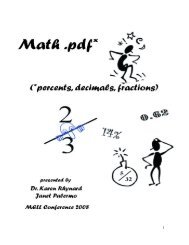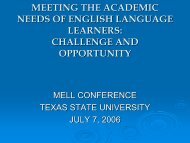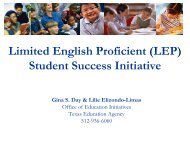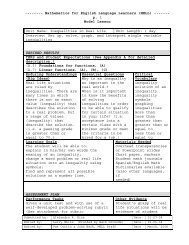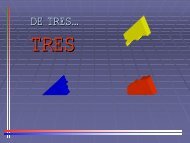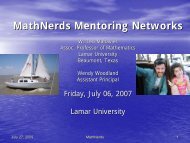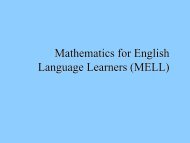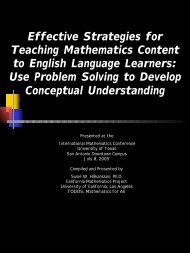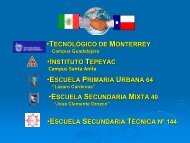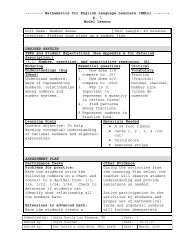Geometric patterns - Mathematics for English Language Learners ...
Geometric patterns - Mathematics for English Language Learners ...
Geometric patterns - Mathematics for English Language Learners ...
Create successful ePaper yourself
Turn your PDF publications into a flip-book with our unique Google optimized e-Paper software.
Cross-curricular second<br />
language acquisition/speaking.<br />
The ELL speaks in a variety of<br />
modes <strong>for</strong> a variety of purposes<br />
with an awareness of different<br />
language registers<br />
(<strong>for</strong>mal/in<strong>for</strong>mal) using<br />
vocabulary with increasing<br />
fluency and accuracy in<br />
language arts and all content<br />
areas. ELLs may be at the<br />
beginning, intermediate,<br />
advanced, or advanced high<br />
stage of <strong>English</strong> language<br />
acquisition in speaking. In<br />
order <strong>for</strong> the ELL to meet<br />
grade-level learning<br />
expectations across the<br />
foundation and enrichment<br />
curriculum, all instruction<br />
delivered in <strong>English</strong> must be<br />
linguistically accommodated<br />
(communicated, sequenced, and<br />
scaffolded) commensurate with<br />
the student's level of <strong>English</strong><br />
language proficiency. The<br />
student is expected to:<br />
language commensurate with<br />
grade-level learning<br />
expectations; and<br />
(c)(2)(I) - demonstrate<br />
listening comprehension of<br />
increasingly complex spoken<br />
<strong>English</strong> by following<br />
directions, retelling or<br />
summarizing spoken messages,<br />
responding to questions and<br />
requests, collaborating with<br />
peers, and taking notes<br />
commensurate with content and<br />
grade-level needs.<br />
[X] (c)(3)(A) - practice<br />
producing sounds of newly<br />
acquired vocabulary such as<br />
long and short vowels, silent<br />
letters, and consonant<br />
clusters to pronounce <strong>English</strong><br />
words in a manner that is<br />
increasingly comprehensible;<br />
(c)(3)(B) - expand and<br />
internalize initial <strong>English</strong><br />
vocabulary by learning and<br />
using high-frequency <strong>English</strong><br />
words necessary <strong>for</strong><br />
identifying and describing<br />
people, places, and objects,<br />
by retelling simple stories<br />
and basic in<strong>for</strong>mation<br />
represented or supported by<br />
pictures, and by learning and<br />
using routine language needed<br />
<strong>for</strong> classroom communication;<br />
(c)(3)(C) - speak using a<br />
variety of grammatical<br />
structures, sentence lengths,<br />
sentence types, and connecting<br />
words with increasing accuracy<br />
and ease as more <strong>English</strong> is<br />
acquired;<br />
(c)(3)(D) - speak using gradelevel<br />
content area vocabulary<br />
in context to internalize new<br />
<strong>English</strong> words and build<br />
academic language proficiency;<br />
(c)(3)(E) - share in<strong>for</strong>mation<br />
in cooperative learning<br />
interactions;<br />
7



